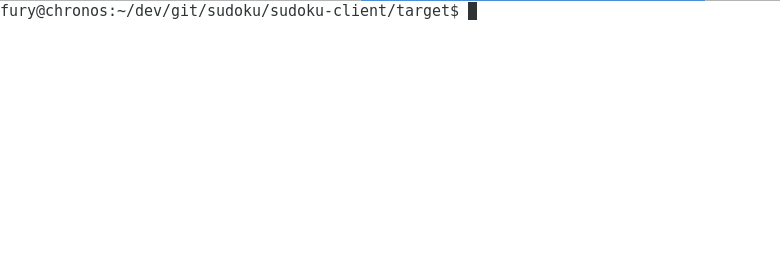A Java implementation of a very fast algorithm for creating Sudoku riddles. Has also the functionality to solve Sudoku riddles.
The following animation shows how quick the provided command line client can create Sudokus:
The riddles can be of the schema dimensions:
- 4x4
- 9x9 (standard size)
- 16x16 (too slow at the moment)
- 25x25 (too slow at the moment)
For building the application you need Apache Maven. Use the following command line:
$ mvn clean package
In the following list I want to give an overview of the features:
- Performance: Very fast algorithm that is using backtracking, but terminates in some fractions of a second. For fully filled boards this is usually less than 1ms on current hardware. For partly-filled riddles this is usually less than 20ms.
- Pureness: Pure Java implementation without any runtime dependencies to other libraries. Runs on Java 8+.
- Quality: High test coverage of >94%. Many (optional) runtime assertions to assure correct operation.
- Output: Plain text, Markdown, LaTeX and JSON output formats. For an example, see 2000-sudokus.pdf, a collection of 2000 Sudokus.
You can review the javadoc for detailed information.
The usage for fully set Sudoku boards (no empty fields) is as following:
GameMatrix matrix = Creator.createFull();You can create a solvable riddle (with empty fields) using
GameMatrix matrix = Creator.createFull(GameSchemas.SCHEMA_9X9);
Riddle riddle = Creator.createRiddle(matrix);A solvable riddle looks like this:
| . | . | 4 | . | . | . | . | 2 | 9 |
| . | 2 | . | . | . | 4 | . | . | . |
| 6 | . | . | . | . | . | . | . | 3 |
| 2 | 4 | . | . | . | 3 | . | . | . |
| 5 | . | . | . | . | . | 9 | . | . |
| . | 7 | . | 5 | . | . | 8 | . | . |
| . | . | . | . | . | 7 | 1 | 6 | . |
| 1 | . | . | . | . | 6 | . | 9 | . |
| . | . | . | 4 | . | 2 | . | . | 8 |
And last but not least you can solve a riddle using
Riddle riddle = new GameMatrixFactory().newRiddle(GameSchemas.SCHEMA_9X9);
riddle.setAll(QuadraticArrays.parse("000000000", ...));
Solver solver = new Solver(riddle);
List<GameMatrix> solutions = solver.solve();For valid riddles you'll find in magazines there is only one solution in the list.
There is also a CLI client that demonstrates the usage of the library.
Please note that the current version is experimental. It creates and solves riddles. The API will change. The library could run into a runtime exception.
There are unit tests for many things, but the code is still young.
The recommended way of including the library into your project is using maven:
<dependency>
<groupId>de.sfuhrm</groupId>
<artifactId>sudoku</artifactId>
<version>4.0.0</version>
</dependency>The design idea is to use the narrowest bottleneck of the Sudoku board to prune the backtracking tree to the maximum and get the fastest results.
The algorithm first fills three blocks with numbers in random order to reduce the amount of backtracking. After that, backtracking for the remaining fields starts.
The field with the least number of possible number candidates on the board is searched. All candidates are tried until the first candidate leads to a valid backtracking tree path. Backtracking occurs in this loop.
It's enough to restrict each backtracking recursion to one field. This means there are no field-dead-ends, only value-dead-ends the algorithm runs in.
This can be proved because as long as the algorithms invariant to only add valid values is true, no fields become dead-ends. The requirement for field-dead-ends is that the surrounding fields have an illegal setup which leads to a rule-violation for each and every value of the field in question.
The version numbers are chosen according to the semantic versioning schema. Especially major version changes come with breaking API changes.
Written 2017-2022 by Stephan Fuhrmann. You can reach me via email to s (at) sfuhrm.de
The project is licensed under LGPL 3.0.


